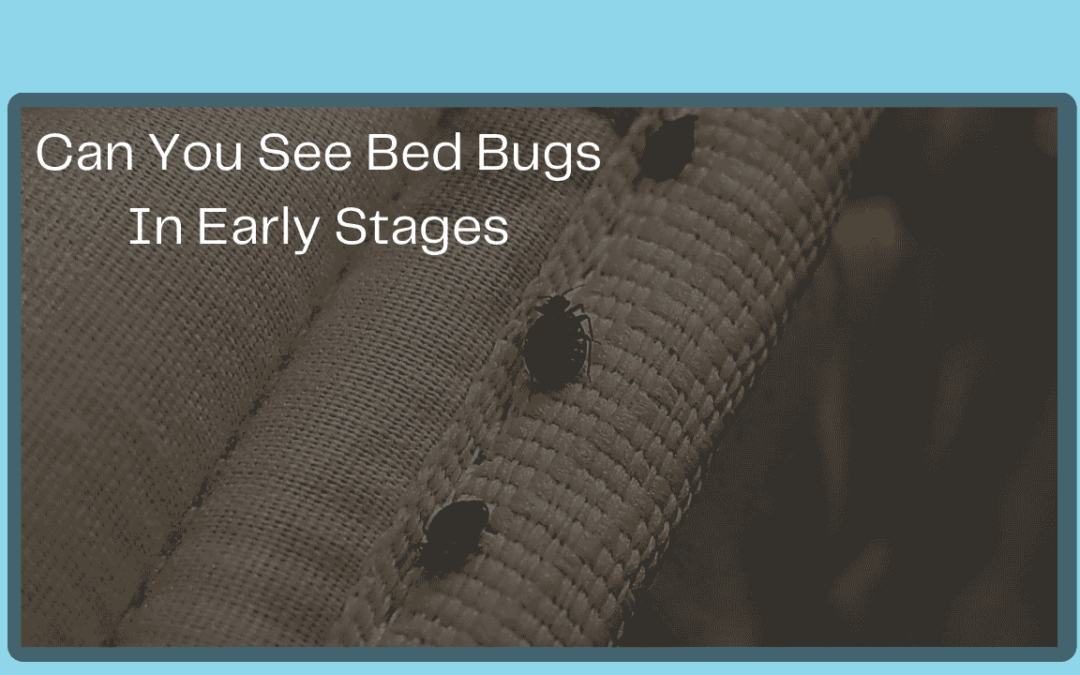Bed bugs are sneaky pests that often go unnoticed until an infestation is severe. But what about spotting them early? Can you see bed bugs in the early stages? The short answer is yes—but it requires sharp observation. This article will guide you on identifying bed bugs during their early stages, why it’s essential, and how to act quickly to prevent further issues.
What Are Bed Bugs? A Quick Overview
Bed bugs are tiny, flat, reddish-brown insects that feed on human blood. These pests thrive in hidden spaces, making them difficult to detect early.
- Size: Adults are about 4-5 mm, while nymphs are much smaller.
- Shape: Oval and flat unless engorged with blood.
- Behavior: Nocturnal and excellent at hiding.
Can You See Bed Bugs in Early Stages?
Yes, you can! However, due to their size and color, identifying bed bugs early can be challenging.
- Nymphs (Baby Bed Bugs): These are pale, almost translucent, and about the size of a poppy seed.
- Eggs: Tiny (1 mm), white, and sticky, often found in clusters.
- Fecal Spots: Small black dots on mattresses, furniture, or walls.
Their appearance changes as they grow. Use a flashlight and a magnifying glass to inspect areas closely.
How to Identify Bed Bugs in Early Stages
Key Signs of Early Bed Bug Activity:
- Small Red Bites: Bed bugs feed on exposed skin, leaving itchy, red welts.
- Shed Skins: As nymphs grow, they shed their exoskeletons. Look for these around hiding spots.
- Blood Stains: Tiny blood smears on bed sheets or clothing are a telltale sign.
Where to Look for Bed Bugs:
| Common Hiding Spots | Description |
|---|---|
| Mattress seams | Bed bugs hide in the edges of mattresses. |
| Furniture crevices | Check under cushions and seams. |
| Baseboards and wall cracks | Tiny gaps in walls offer perfect hiding spots. |
Challenges in Finding Bed Bugs Early
Spotting early signs can be tricky. Bed bugs are experts at hiding, and their eggs and nymphs are nearly invisible to the naked eye.
Why It’s Hard:
- The small size makes them easy to miss.
- They are nocturnal and avoid detection during the day.
Use a flashlight to inspect dark crevices or call pest control experts for a thorough evaluation.
Comparison: Early Signs vs. Full Infestation
Early Stages: Few bugs, minimal bites Inspect and apply treatments.
Infestation: Many bugs and severe bite marks. Professional pest control.
Early detection can save time and money. The earlier you act, the easier it is to control the problem.
Effective Ways to Detect Bed Bugs Early
Follow these steps to identify bed bugs early:
- Inspect Regularly: Check bedding and furniture for bugs or eggs.
- Use Bed Bug Traps: Sticky traps can capture wandering bugs.
- Monitor Bites: Track patterns of bites over time.
Professional Methods to Find Bed Bugs in Early Stages
Pest control companies use advanced methods, such as:
- Canine Inspections: Trained dogs detect bed bug scents.
- Thermal Imaging: Identifies hidden infestations with heat sensors.
- Chemical Testing: Residues reveal the presence of bed bugs.
Preventing a Full-Blown Bed Bug Infestation
- Clean and Declutter: Remove unnecessary items to limit hiding spots.
- Wash Fabrics: Use hot water and a dryer to kill eggs and nymphs.
- Encase Mattresses: Use bedbug-proof covers to block access.
Pro Tip: Regular inspections can stop infestations before they spread.
Table: Early Detection vs. Delayed Action
| Aspect | Early Detection | Delayed Action |
|---|---|---|
| Cost | Lower treatment costs | Expensive extermination services |
| Effort | Minimal effort | Intense cleaning and treatments |
| Success Rate | Higher due to limited spread | Lower as infestation worsens |
When to Call Pest Control Experts
If you suspect bed bugs but can’t confirm, it’s time to call professionals. Pest control services offer:
- Accurate identification of the problem.
- Targeted treatments for complete eradication.
- Guidance on preventing future infestations.
Check our Pest Control Services for assistance.
Conclusion
Finding bed bugs in their early stages is challenging but not impossible. Regular inspections and understanding key signs can save you from a full-blown infestation. You can protect your home and family from these pests by acting promptly and using proper techniques. Don’t hesitate to seek professional help if you’re uncertain or overwhelmed.
For more tips and resources, visit our blog:
ঢাকায় ছারপোকার সমস্যা?
CarePest-এর সাথে যোগাযোগ করুন। আমরা পেশাদার পদ্ধতিতে আপনার বাড়ি বা ব্যবসার স্থান থেকে ছারপোকা নির্মূল করি। আমাদের দ্রুত, নির্ভরযোগ্য, এবং সাশ্রয়ী সেবাগুলি দিয়ে আপনার স্থানটি ছারপোকামুক্ত করুন।.

